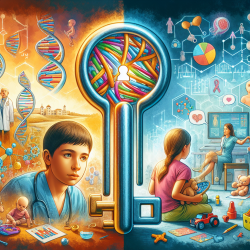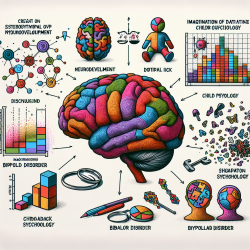Understanding the Genetic Complexity of Autism
Autism Spectrum Disorders (ASD) are a diverse group of neurodevelopmental conditions characterized by challenges in social communication and behavior. The genetic underpinnings of ASD are complex, involving multiple genes and environmental factors. Recent research, particularly the study titled "Genetic and Functional Analyses of SHANK2 Mutations Suggest a Multiple Hit Model of Autism Spectrum Disorders," sheds light on the role of SHANK2 mutations in ASD.
The SHANK2 Gene and Its Role in Autism
SHANK2 is a gene that encodes a protein crucial for synaptic function. Mutations in SHANK2 have been linked to ASD, suggesting that disruptions in synaptic pathways are significant contributors to the disorder. The study highlights the presence of SHANK2 mutations in a subset of individuals with ASD, emphasizing the gene's role in synaptic gene dysfunction.
Key Findings from the SHANK2 Study
The research identified several key points about SHANK2 mutations:
- SHANK2 mutations were found to reduce synaptic density, impacting neuronal communication.
- Patients with SHANK2 deletions often had additional genetic variations, supporting the "multiple hit model" of ASD.
- These genetic interactions suggest that multiple genetic factors contribute to the development of ASD.
Implications for Practitioners
For practitioners working with children with ASD, understanding the genetic basis of the disorder can enhance therapeutic approaches. Here are some ways practitioners can apply these findings:
- Genetic Counseling: Consider genetic testing for families, which can provide insights into the specific genetic factors involved in a child's ASD.
- Personalized Therapy: Tailor interventions based on genetic profiles to address specific synaptic dysfunctions.
- Collaborative Research: Engage in research collaborations to explore the impact of SHANK2 mutations further and develop targeted therapies.
Encouraging Further Research
While the study provides valuable insights, it also highlights the need for further research. Practitioners are encouraged to stay informed about ongoing research and consider participating in studies that explore the genetic basis of ASD. This involvement can lead to the development of more effective interventions and improved outcomes for children with ASD.
Conclusion
The study of SHANK2 mutations offers a glimpse into the genetic complexity of ASD. By understanding these genetic interactions, practitioners can better support children with ASD and their families. As research progresses, the hope is to develop more personalized and effective therapeutic strategies.
To read the original research paper, please follow this link: Genetic and Functional Analyses of SHANK2 Mutations Suggest a Multiple Hit Model of Autism Spectrum Disorders.










